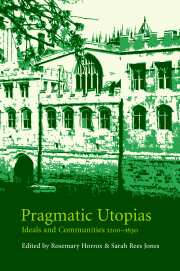Book contents
- Frontmatter
- Contents
- Preface
- List of abbreviations
- Richard Barrie Dobson: an appreciation
- 1 ‘If heaven be on this earth, it is in cloister or in school’: the monastic ideal in later medieval English literature
- 2 The ‘Chariot of Aminadab’ and the Yorkshire priory of Swine
- 3 Godliness and good learning: ideals and imagination in medieval university and college foundations
- 4 Hugh of Balsham, bishop of Ely 1256/7–1286
- 5 A cruel necessity? Christ's and St John's, two Cambridge refoundations
- 6 Coventry's ‘Lollard’ programme of 1492 and the making of Utopia
- 7 Thomas More's Utopia and medieval London
- 8 Social exclusivity or justice for all? Access to justice in fourteenth-century England
- 9 Idealising criminality: Robin Hood in the fifteenth century
- 10 Fat Christian and Old Peter: ideals and compromises among the medieval Waldensians
- 11 Imageless devotion: what kind of an ideal?
- 12 An English anchorite: the making, unmaking and remaking of Christine Carpenter
- 13 Victorian values in fifteenth-century England: the Ewelme almshouse statutes
- 14 Puritanism and the poor
- 15 Realising a utopian dream: the transformation of the clergy in the diocese of York, 1500–1630
- Bibliography of Barrie Dobson's published works
- Index
9 - Idealising criminality: Robin Hood in the fifteenth century
Published online by Cambridge University Press: 01 July 2009
- Frontmatter
- Contents
- Preface
- List of abbreviations
- Richard Barrie Dobson: an appreciation
- 1 ‘If heaven be on this earth, it is in cloister or in school’: the monastic ideal in later medieval English literature
- 2 The ‘Chariot of Aminadab’ and the Yorkshire priory of Swine
- 3 Godliness and good learning: ideals and imagination in medieval university and college foundations
- 4 Hugh of Balsham, bishop of Ely 1256/7–1286
- 5 A cruel necessity? Christ's and St John's, two Cambridge refoundations
- 6 Coventry's ‘Lollard’ programme of 1492 and the making of Utopia
- 7 Thomas More's Utopia and medieval London
- 8 Social exclusivity or justice for all? Access to justice in fourteenth-century England
- 9 Idealising criminality: Robin Hood in the fifteenth century
- 10 Fat Christian and Old Peter: ideals and compromises among the medieval Waldensians
- 11 Imageless devotion: what kind of an ideal?
- 12 An English anchorite: the making, unmaking and remaking of Christine Carpenter
- 13 Victorian values in fifteenth-century England: the Ewelme almshouse statutes
- 14 Puritanism and the poor
- 15 Realising a utopian dream: the transformation of the clergy in the diocese of York, 1500–1630
- Bibliography of Barrie Dobson's published works
- Index
Summary
The urge to speak of Robin Hood by those who never bent his bow remains undiminished. Why therefore yet another voice? There are two answers: one is that a volume such as this would surely be incomplete without a chapter on the medieval outlaw whom Barrie Dobson has made his own, and the other is that, curiously, in all the recent speakings no one has directly addressed what the tales of Robin Hood said to fifteenth-century audiences who heard them in the form in which they were subsequently set down in their earliest surviving versions. There has been endless speculation about a possible original ‘real-life’ Robin. Much has been written in relation to the context in which the ballads are apparently set, sometime around 1300. Considerable thought has been given to the composition of their audience. The literary qualities, structure and antecedents of the ballads have been exhaustively analysed. Yet not even in the work of Holt, or of Dobson and Taylor, is the content of the tales examined with a view to what they say specifically to a fifteenth-century audience.
This neglect is to some extent surprising, since it is established that the earliest ballads took the form we know in the first half of the century. Dobson and Taylor, in their most recent discussion, judge that the tales began to survive in written form ‘no later than the mid-fifteenth century’. Linguistic analysis of the Gest has suggested a date of composition as early as c. 1400.
- Type
- Chapter
- Information
- Pragmatic UtopiasIdeals and Communities, 1200–1630, pp. 156 - 173Publisher: Cambridge University PressPrint publication year: 2001



